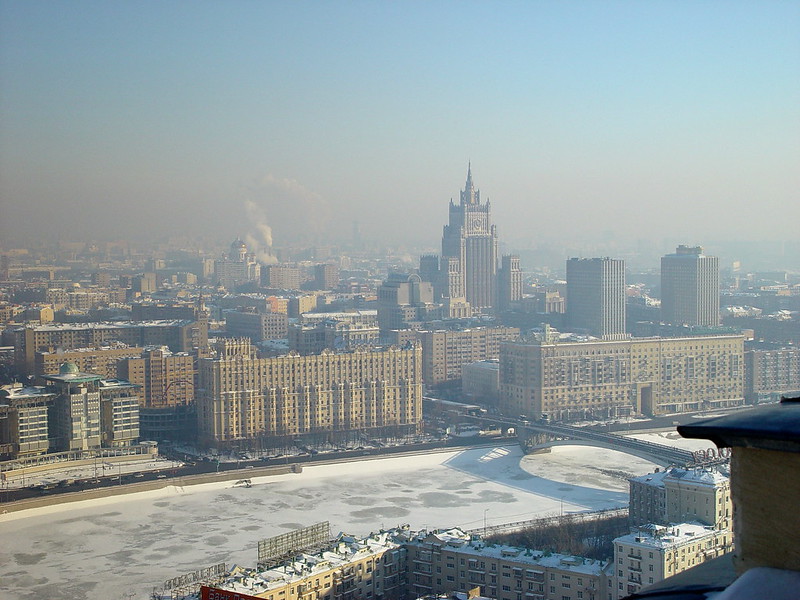
Moscow in autumn. Image by Loris Silvio Zecchinato via flickr.com. License: Creative Commons
The USA is imposing new sanctions on Russian financial companies – this time also on the Moscow Stock Exchange. Dollar-ruble trading is thus moving completely underground, including to Tether and Bitcoin.
On June 12, the US Treasury Department announced a new round of sanctions against 300 Russian targets.
The Treasury Department says the reason is that Russia is completing the transition to a full war economy. The line between civilian and military economy is blurring, no element of the economy is innocent anymore, and every penny that interacts with Russia is potentially smeared with blood.
The sanctions have several objectives. They are intended to strengthen the secondary sanctions that affect financial institutions in third countries if they cooperate with Russia’s war economy. They are also intended to largely prevent Russian industry from accessing American, European and Asian software and IT services.
In addition to a long list of Russian technology companies, the sanctions primarily affect the financial sector. Not only Russian banks themselves are sanctioned, but also their branches abroad, in China, India, and Kyrgyzstan. Above all, central institutions of the Russian financial infrastructure also end up on the blacklists, such as the Moscow Stock Exchange (MOEX), the National Clearing Center (NCC), and the National Settlement Depository (NSD).
Russia’s ruler Vladimir Putin has long been talking about “dedollarization” – now the USA is forcing dedollarization. Russia’s financial sector is now cut off from the dollar, and official ruble-dollar trading is dead.
The news initially caused something like panic in the Russian financial sector. The Moscow Stock Exchange went offline, and numerous large banks, such as Gazprombank, blocked logins to prevent something like a bank run.
The dollar market has meanwhile disappeared into the black market. Cryptocurrencies also play a role here. Cryptocurrencies, especially Bitcoin and Tether Dollar (USDT), have long served as a vehicle for Russian companies to bypass sanctions and do business with trading partners around the world, especially in Asia. Now this change could logically also spread to foreign exchange trading.
Both Russia and the US, in rare agreement, want the dedollarization of the country. The markets, on the other hand, want redollarization, and USDT is the instrument of choice for this.
However, the markets in Russia are often not very liquid. Although cryptocurrencies are widely used in Russia, from ordinary citizens to the top of the government, from hackers to secret services, from technology importers to oil exporters, trading itself still takes place in a gray area, while Russia and the ruble remain red flags for international exchanges.
One of the most important Russian crypto exchanges is Garantex. There is a lively trading of rubles for dollar tokens, Bitcoin and Ethereum. Here and on other platforms one can still observe the electronic dollar-ruble trading, which officially no longer exists.
As is usually the case when price discovery moves into the underground and grey markets, the official and market prices begin to diverge. While you officially pay 89 rubles for a dollar, one USDT costs almost 92 rubles. A similar premium of around three percent can also be found with Bitcoin.
Overall, however, the consequences for the Russian financial industry seem to be rather limited, if that can be said two days later. The fog has lifted after the initial shock, the MOEX is back online, the banks are reopening logins. The price of the ruble has dropped slightly, the MOEX rate has fallen slightly. But a crash looks different.
The price discovery of the ruble against the dollar has become more confusing and volatile. But that is not dramatic. According to Reuters, 60 percent of foreign exchange trading this year is already taking place OTC, i.e. over-the-counter, outside of the stock exchanges. This is simply forcing a trend to complete itself; cryptocurrencies continue to provide liquid electronic trading that enables transparent real-time price discovery.
Another trend was also accelerated by the sanctions. In May, the Chinese yuan replaced the dollar as the most important currency in ruble trading. Around 54 percent of the foreign currency market was in yuan. The dollar and euro have lost a lot of influence in Russian finance over the past two years, and their smooth landing is now hitting the ground a little bumpy.
Consequently, the Russian central bank has now made official what was already the case: the yuan is replacing the dollar as the leading currency. On the Moscow stock exchange, the yuan-ruble pair will now serve as the reference point for all other currency pairs. The yuan will thus become a proxy for the dollar, just as the dollar used to be a proxy for gold in the Bretton Woods system.
The division of the global currency areas has thus reached a new level. As expected, the yuan is proving to be the biggest competitor to the dollar.
However, there is still no sign of a de-dollarization of global trade. The dollar is still by far the most important currency. Despite some efforts by the BRICS countries to reduce their dependence on the dollar, it has not only been able to maintain its position as the global reserve currency in recent years, but has even expanded it.
However, with Russia’s link to the Yuan, the shift in the international currency structure is likely to enter a new phase. It is not yet clear whether this step will also be ignored by the dollar or whether it will trigger a dynamic that will sustainably increase the Yuan’s position.
Cryptocurrencies such as Bitcoin and USDT will play a certain role in this, even if they are not yet in the spotlight. Bitcoin is waiting in the wings as a third option alongside the dollar and yuan, whether as a unit of account or settlement currency. Tether stablecoins such as USDT serve as the currency that the markets want to counteract de-dollarization, and perhaps even redirect it towards re- and hyper-dollarization, in which the classic US financial sanctions are suspended.
At the same time, crypto markets will become important whenever there is a crack in the structure. When governments regulate and limit trading, when they set prices and force the market to go underground, crypto markets will provide liquidity and help to find and recognize prices.
Discover more from BitcoinBlog.de – the blog for Bitcoin and other virtual currencies
Sign up to receive the latest posts via email.
Source: https://bitcoinblog.de/2024/06/14/neue-finanzsanktionen-yuan-loest-dollar-ab/


